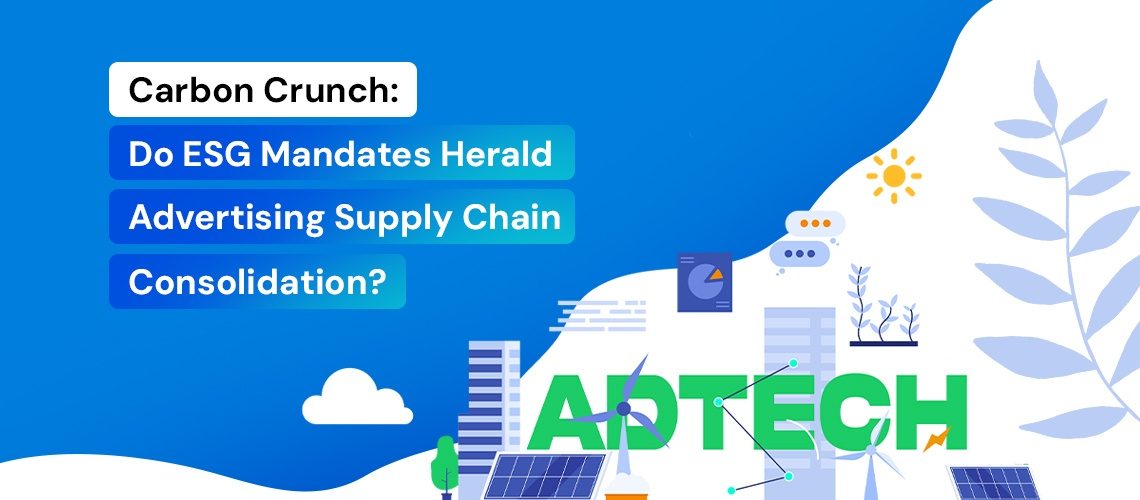The internet kicks out as much carbon dioxide as aviation, with advertising a major component. But brands – almost all of the world’s major advertisers – have committed to decarbonize their operations and supply chains, including media and advertising, some within the next few years.
If the phasing out of cookies wasn’t enough of a challenge, carbon mandates present another existential threat to the sprawling adtech supply chain, because publishers are now incentivized to audit their ad stacks and technology partnerships. If they are not actively seen to reduce emissions, publishers stand to lose their share of marketing budgets.
And now some firms – including the world’s biggest comms holding companies – are shining a light on the biggest causes of emissions within the digital ad supply chain, and showing brands where they can lessen the carbon footprint of their advertising.
The upshot is that a big chunk of the $600 billion globally spent on digital advertising may ultimately be channeled to publishers with the ‘cleanest’ supply chains and smallest carbon footprint.
Which means a clean out – and significant consolidation – is inevitable. And it is likely to start in the $100 billion programmatic market.
Crunch time

GroupM, the media buying arm of WPP, which last year placed $64 billion in advertising on behalf of clients, has committed to become ‘net zero’ across its entire supply chain by 2030. Whether it can achieve that ambition is debatable. But it definitely cannot if it places ads with publishers that are net carbon emitters, because the vast bulk, circa 98 percent of WPP’s carbon footprint, is wrapped up in the supply chain. And while some of that carbon is down to production – making ads, content and the like – the biggest component by far is media.
The holdco is working with VC-backed tech firm Scope3, led by Brian O’Kelley, the former co-founder and CEO of AppNexus and known as ‘the inventor of ad exchanges’, with AppNexus the first globally to offer real time bidding, even ahead of Google. Suffice to say, O’Kelley knows where the problems lie in terms of the overlap and waste inherent within the digital ad supply chain – which is linked directly to its bloated carbon footprint.
O’Kelley is telling publishers to slash those supply chains, fast, in order to cut their carbon footprints, get more cents on the ad dollar – and more ad dollars full stop.
He’s telling advertisers the other side of that story, i.e. that buying low-grade digital inventory is a massive waste of marketing budget while adding directly to carbon emissions.
“Anything that gets no attention or low attention, stop buying. Anything that’s not where your eyeballs are is waste, both from a marketing perspective and from a carbon perspective. That is very simple hygiene,” said O’Kelley earlier this year.
“We can demand shorter supply paths for programmatic. We can stop buying crappy inventory. We can stop buying on ‘made for advertising’ [sites]. If we all stop buying crappy outstream video, I’m pretty sure that would have a massive impact.”
Cutting suppliers
O’Kelley suggests publishers can halve their digital ad emissions within 12 months by evaluating and then culling digital supply chain partners. Even making small tweaks to the programmatic set up can yield major results, per O’Kelly, who urged advertisers to put pressure on publishers to take action.
“Case after case, we’ve seen that by turning off five to seven percent of inventory, you get a 29 or 30 percent reduction in carbon. And so far, we’ve not seen any impact to performance,” he suggested.
“The reason is because there’s so many intermediaries, there’s so much money going to non-working media in programmatic that you’re actually squeezing out the non working part and your media is actually working better for you.”
Scope3, which last month raised another $20m in funding to scale its operations globally has now opened up its ad emissions database to brands and the media supply chain.
That means advertisers can see which websites, apps and CTV channels have a lower footprint than others. Which could see the money start to move faster.
Easy wins

The IAB, which represents digital publishers and the digital ad supply chain, is alive to the incoming challenge facing its members.
In June, its Tech Lab division published a ‘sustainability playbook’ aimed at media suppliers and buyers outlining initial steps to clean up programmatic auctions dynamics.
For the sell-side, key actions include culling waste and duplication in the bid stream, booting out exchanges contributing little or no revenue while piggybacking their audience data via cookie syncing, and always setting a bid price floor, thereby stopping wasted bids from buyers in auctions they cannot win.
The playbook makes similar efficiency recommendations for buy-side around limiting the number of needless – and often valueless – transactions and bids in the chain, and obvious actions such as avoiding ‘made for advertising’ sites.
It also advises advertisers to make sure ads are as digitally light as possible, with tweaks to creative weight and resolution enabling circa 30 percent carbon reductions.
Arms race
A number of other ‘clean’ adtech firms – some led by former programmatic execs – are now making headway with brands and ad agencies
The likes of SeenThis works with all major ad holding groups, as well as advertisers like Coca-Cola, Levi’s, Nissan, and Renault. Whereas most ad servers work by making users download ads before they can be displayed, the Swedish firm’s technology streams ads that it has pre-optimized, minimizing data, and thereby carbon.
Companies operating in similar spaces include Good-Loop, Adlook and AdGreen – and there are others entering what appears to be becoming a carbon reduction arms race.
The challenge for advertisers is picking a winner with robust methodology and proof of their carbon claims. The lack of defined industry standards around carbon measurement is something GroupM is bidding to corral industry to solve. Per global boss Christian Juhl, everybody working to different sets of numbers leads to advertiser distrust and inertia.
But global standards or not, Scope 3’s Brian O’Kelley thinks advertisers with ESG mandates and KPIs have everything to gain by assessing their digital ad supply chains and culling the components adding little or no value – whether in the name of carbon reduction or just efficiency.
“I think programmatic advertising will be cost effective for the first time in a long time once we do this work,” per O’Kelley. “The last few years, I don’t think it’s been actually worth the investment. It will be once we’re done.”


